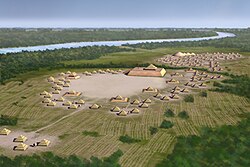Spiro Mound Group | |
 Artist's conception of Spiro Mounds, viewed from the west | |
| Nearest city | Spiro, Oklahoma |
|---|---|
| Coordinates | 35°18′43″N 94°34′07″W / 35.31194°N 94.56861°W |
| Area | Le Flore County |
| Architectural style | Mississippian |
| NRHP reference No. | 69000153 |
| Added to NRHP | September 30, 1969[1][2] |

Spiro Mounds (34 LF 40)[3] is an Indigenous archaeological site located in present-day eastern Oklahoma. The site was built by people from the Arkansas Valley Caddoan culture.[4] that remains from an American Indian culture that was part of the major northern Caddoan Mississippian culture. The 80-acre site is located within a floodplain on the southern side of the Arkansas River. The modern town of Spiro developed approximately seven miles to the south.
Between the 9th and 15th centuries, the local Indigenous people created a religious and political center, culturally linked to the Southeastern Ceremonial Complex identified by anthropologists as the Mississippian Ideological Interaction Sphere (MIIS). Spiro was a major western outpost of Mississippian culture which dominated the Mississippi Valley and its tributaries for centuries.
In the 1930s during the Great Depression, treasure hunters bought the rights to tunnel into Craig Mound—the second-largest mound on the site—to mine it for artifacts. Without concern for scientific research, they exposed a hollow burial chamber inside the mound, a unique feature containing some of the most extraordinary pre-Columbian artifacts ever found in the United States. The treasure hunters sold the artifacts they recovered to art collectors, some as far away as Europe. The artifacts included works of fragile, perishable materials: textiles and feathers that had been uniquely preserved in the conditions of the closed chamber.
Later, steps were taken to protect the site. This site has been significant for North American archaeology since the 1930s, especially due to its many preserved textiles and a wealth of shell carving. Later, some of the artifacts sold by treasure hunters were returned to regional museums and the Caddo Nation, but many artifacts from the site have never been accounted for.
Since the late 20th century, the Spiro Mounds site has been protected by the Oklahoma Historical Society and it is listed on the National Register of Historic Places.[5]
- ^ "OKLAHOMA - Le Flore County". National Register of Historic Places. National Park Service. January 23, 2007.
- ^ "National Register Properties in Oklahoma". Retrieved February 28, 2009.
- ^ Brown, James A.; Rogers, J. Daniel (Summer 1989). "Linking Spiro's artistic styles: The Copper Connection". Southeastern Archaeology. 8 (1): 1–8. JSTOR 40712893.
- ^ Cite error: The named reference
avccwas invoked but never defined (see the help page). - ^ "Spiro Mounds." Oklahoma Historical Society. (retrieved 30 May 2011)

